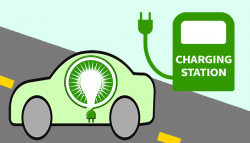How and Where to Charge Your Plug-in Electric Vehicle
 Plug-in electric vehicles (PEVs) are increasing in popularity due to their environmental benefits as well as significantly reduced fuel costs for PEV owners. It’s also a great time to buy due to available federal, state, and local incentives which significantly decrease the cost of a PEV (more on this in a later article). But some folks still worry about charging. Where can I charge my PEV? Will charging be convenient enough? Let’s explore these questions.
Plug-in electric vehicles (PEVs) are increasing in popularity due to their environmental benefits as well as significantly reduced fuel costs for PEV owners. It’s also a great time to buy due to available federal, state, and local incentives which significantly decrease the cost of a PEV (more on this in a later article). But some folks still worry about charging. Where can I charge my PEV? Will charging be convenient enough? Let’s explore these questions.
Though it’s not the only option, many plug-in electric vehicle owners opt to charge at home for convenience. It’s easy to plug in before bed and unplug when heading out for work the next morning. Most PEVs come with a connector that allows you to plug your vehicle into a standard household outlet. This is known as AC level 1 charging. Owners also have the option of installing a charging station at their home to achieve a faster charge. The most popular home charging stations are AC level 2. Also known as “destination charging,” AC level 2 charging stations are typically installed at workplaces, homes, hotels, and shopping areas where PEV owners normally spend several hours and can conveniently charge their vehicle.
Reading Municipal Light Department (RMLD) offers residential customers a rebate of 100% of equipment costs up to $500 for the home installation of a networked (or “smart”) AC level 2 charging station. For more information, click here.
In addition to home charging, public charging stations have become more prevalent and are now commonly found at hotels, shopping centers, restaurants, public parking lots, workplaces, parking garages, and more. Public charging stations are either AC level 2, or DC Fast Charge. Today, there are around 300 public charging stations in Massachusetts alone. PlugShare (https://www.plugshare.com/) is a great resource for PEV owners looking for public charging stations. The site offers a map of available stations including information on each station’s type, plug compatibility, rate, and network.
This chart illustrates the various types of charging available and how long it takes to charge by each type:
TYPES OF CHARGING | AC Level 1 | AC Level 2 | DC Fast Charge |
|---|---|---|---|
Description | Standard Household Outlet | Charging Station | Charging Station |
Power Level | 120 volts | 240 volts | 480 volts |
Range to Charge Ratio | 2 to 5 miles of range per one hour of charge | 10 to 20 miles of range per one hour of charge | 60 to 80 miles of range per 20 minutes of charge |
To learn about PEVs and charging, join RMLD for a Plug-in Electric Vehicle Ride and Drive Event on Sunday, July 15, 2018 from 10:00 am – 2:00 pm in the Swain Green parking lot, which is located at the corner of Middlesex Avenue and School Street in Wilmington across from the Town Common.
This is the third in a series of articles RMLD will publish this summer regarding plug-in electric vehicles. Be on the lookout for our next article: Available Incentives to Reduce the Purchase Price of a Plug-in EV. Click here to view the complete series of articles.

